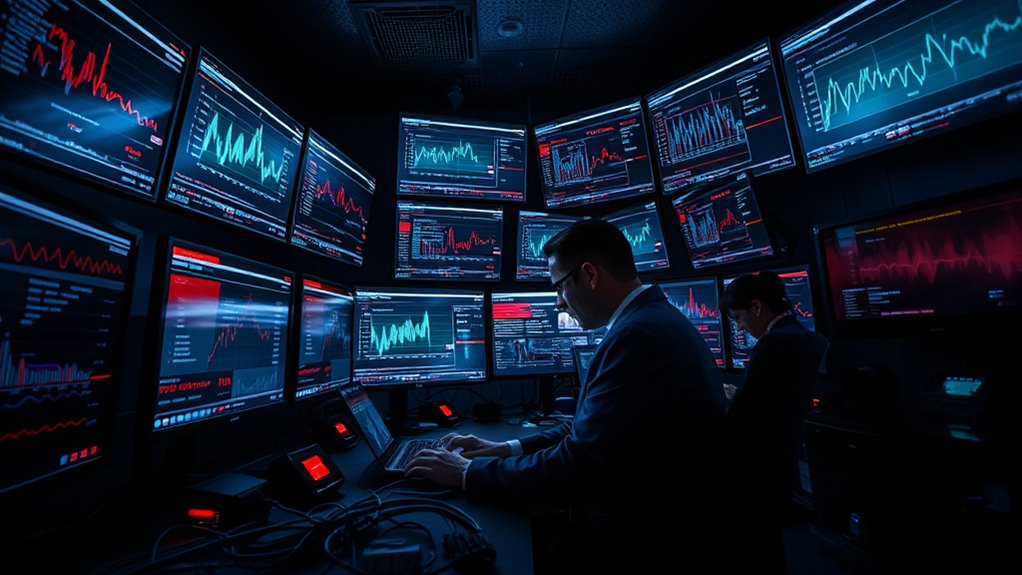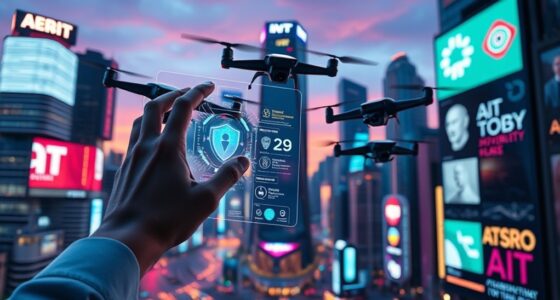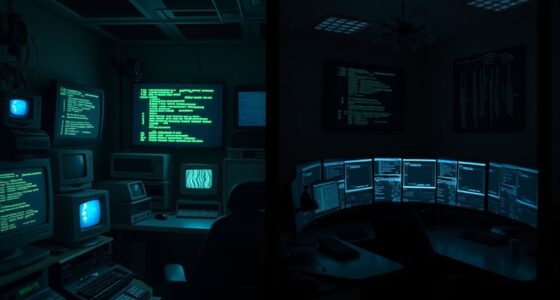In 2025, cyber threats escalated, with a surge in sophisticated phishing scams and insider breaches. You need to recognize that attackers blended technical exploits with social engineering tactics, making it essential to adapt your defenses. Strengthening employee training and access controls has never been more critical. Fostering a culture of cybersecurity awareness can help protect your organization. To discover more about evolving threats and how to stay ahead, keep exploring these important lessons.
Key Takeaways
- Phishing scams surged in 2025, highlighting the need for employee training on recognizing and responding to suspicious communications.
- Cyber attackers increasingly combined technical exploits with social engineering, necessitating advanced defensive strategies to counteract evolving threats.
- Insider threats emerged as significant risks, underscoring the importance of strict access controls and monitoring systems to protect sensitive information.
- Organizations must foster a culture of cybersecurity awareness, encouraging open discussions and proactive responses to potential threats.
- Continuous improvement and preparedness are essential, as the dynamic cyber threat landscape demands vigilance and adaptive security measures.

As cyber threats evolve, 2025 proved to be a watershed year for major cyber attacks that shook industries and governments alike. You probably noticed how the landscape changed dramatically, as hackers became more sophisticated and targeted. One of the most alarming trends was the surge in phishing scams, which exploited human vulnerabilities like never before. It became clear that cybercriminals were no longer just relying on technical exploits; they were also honing their social engineering skills to manipulate individuals into divulging sensitive information.
The evolving cyber threat landscape of 2025 saw hackers leveraging sophisticated phishing scams to exploit human vulnerabilities like never before.
The rise of sophisticated phishing scams made it essential for you to stay vigilant. These scams weren’t just simple emails anymore; they came in various forms, including fake websites and SMS messages that looked legitimate. You may have encountered situations where a message from what appeared to be your bank requested immediate action. If you clicked without thinking, you could have unknowingly handed over your credentials to cybercriminals. It’s a stark reminder of how easily trust can be exploited in the digital age.
In addition to external threats, insider threats became a pressing concern during this year. These threats often stemmed from employees or contractors who either acted maliciously or inadvertently exposed sensitive data. You might have heard about high-profile incidents where trusted insiders leaked confidential information, leading to significant financial and reputational damage. Organizations had to rethink their security strategies, focusing not only on external defenses but also on safeguarding against potential breaches from within.
The lessons learned from these incidents were profound. You realized that training employees on recognizing phishing attempts wasn’t just a checkbox exercise; it was a necessity. Regular workshops and simulated phishing attacks could help cultivate a culture of awareness within your organization. *Furthermore*, implementing strict access controls and monitoring systems could mitigate insider threats by ensuring that only authorized personnel had access to sensitive information. In this context, fostering a safe space for expressing feelings around cybersecurity can encourage open communication and proactive measures among team members.
As you reflect on the cyber landscape of 2025, it’s clear that the stakes have never been higher. You can’t afford to be complacent; proactive measures are essential to staying ahead of evolving threats. By understanding the risks posed by phishing scams and insider threats, you can better protect yourself and your organization. The key is to foster a culture of cybersecurity that empowers everyone to be vigilant and informed. Remember, in the ever-changing world of cyber threats, awareness and preparedness are your best defenses.
Frequently Asked Questions
What Industries Were Most Affected by the Cyber Attacks in 2025?
The financial sector and healthcare systems were the most affected industries in 2025. You’d see banks struggling with data breaches, leaving customers vulnerable to fraud. Meanwhile, healthcare systems faced disruptions, impacting patient care and access to essential medical information. Both sectors lost trust from the public, leading to long-lasting repercussions. As you navigate these challenges, it’s important to understand the vulnerabilities and implement stronger cybersecurity measures to safeguard against future attacks.
How Can Individuals Protect Themselves From Similar Attacks?
To protect yourself from cyber attacks, focus on personal cybersecurity and maintain good digital hygiene. Start by using strong, unique passwords and enabling two-factor authentication on your accounts. Regularly update your software and devices to patch security vulnerabilities. Be cautious with suspicious emails or links, and avoid sharing sensitive information online. Additionally, consider using a reputable antivirus program to help identify and block potential threats, keeping your digital life safer.
Were There Any Notable Perpetrators Behind These Attacks?
Yes, there were notable perpetrators behind these attacks, including state-sponsored hackers and insider threats. State-sponsored hackers often target critical infrastructure and sensitive data, using advanced techniques to breach security. You need to stay vigilant against these threats, as they can be sophisticated and coordinated. Additionally, insider threats can arise from disgruntled employees or mistakes, making it essential for you to monitor access and implement strict security protocols to protect your information.
What Technologies Were Exploited During the Cyber Attacks of 2025?
During the cyber attacks of 2025, hackers exploited quantum vulnerabilities and targeted IoT devices. You’d notice how weak encryption algorithms could no longer safeguard sensitive data against quantum computing threats. Additionally, unsecured IoT devices became prime targets for breaches, allowing attackers to infiltrate networks and access critical systems. It’s essential to stay informed about these technologies to enhance your defenses and protect against future threats. Cybersecurity must adapt to these evolving risks.
How Did Governments Respond to the Attacks in Real-Time?
Governments responded swiftly to the attacks with real-time coordination among agencies. They activated emergency response teams, sharing intelligence to mitigate damage and protect critical infrastructure. You’d see increased communication between federal, state, and local authorities, ensuring a unified front against the cyber threats. They also implemented immediate cybersecurity measures, prioritizing vulnerable sectors and enhancing public awareness to prevent further breaches. This proactive approach aimed to restore confidence and security in their systems.
Conclusion
In reflecting on the major cyber attacks of 2025, you realize that vigilance and adaptability are essential. Just like the Roman legions adapted their tactics over centuries, you must continuously evolve your defenses against emerging threats. The lessons learned highlight the importance of collaboration, education, and robust security measures. By staying informed and proactive, you can better safeguard your digital assets and guarantee resilience against future attacks. Don’t wait for the next breach; act now to protect what matters.









